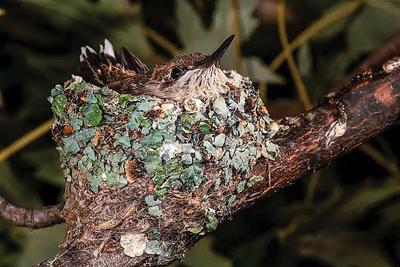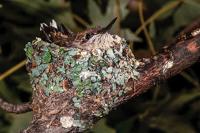After hearing from several Leader readers about observing fewer hummingbirds this spring, I checked in with state Department of Conservation ornithologist Kristen Heath-Acre to learn if there was an issue with the little bird’s numbers.
While other migratory bird populations have plummeted, she said the hummers are actually increasing.
Referencing the Cornell Lab of Ornithology, Heath-Acre said, “eBird trend maps show ruby-throated hummingbirds are increasing or maintaining populations in Missouri in the past 10 years.”
I also thought I had seen fewer birds this spring at my feeders, and now that the season has changed to summer, my nectar offering seems more likely to attract downy woodpeckers and an occasional finch to its red flowers, rather than hummingbirds.
“As the weeks pass in the summer, the birds pair up and spread out across the landscape over territories that the male defends for the female to build a nest and raise their young,” Heath-Acre said. “As hummingbirds spread out to breeding territories, they are naturally not as concentrated in flocks that we see at feeders initially in the spring.”
While that explains the dog days dilemma, why were their fewer in some places this spring? My neighbor Steve reported that his usual entourage (more like a swarm) was here earlier, and others I’ve heard from told similar stories, but what about those other observations?
“Regrettably, we have no way of knowing why they don’t always return to feeders they’ve previously visited,” Heath-Acre said. “It’s possible they could’ve found a better place to migrate through or perhaps they stopped to fill up their tanks at another property.
“These situations are tough because folks watch hummingbirds yearly for many years, and it’s no fun when they don’t refuel there or stop coming. We’re just not sure.”
Weather events, storms, habitat destruction, mortality or any number of other factors can affect the timing and locations of bird migration annually, she said.
“Those threats vary across the different parts of a migratory bird’s range, from the breeding range up here to stop-over sites during migration and on the wintering grounds,” Heath-Acre said.
The silver lining remains that the ruby-throated hummingbird is faring well, but comprehensive studies analyzed by the Cornell Lab show North American bird populations are down by nearly three billion since 1970.
Common birds – the species that many people see every day – have suffered the greatest losses, according to birds.cornell.edu. More than 90 percent of the decline comes from just a dozen bird families, such as sparrows, blackbirds, warblers, and finches.
The losses include favorite species seen at bird feeders, such as dark-eyed juncos (also known as snowbirds), down by 168 million, and white-throated sparrows down by 93 million. Eastern and western meadowlarks have lost a combined 139 million in the past half century.
“We want to keep common birds common, and we’re not even doing that,” said Pete Marra, a study coauthor who formerly directed the Smithsonian Migratory Bird Center and now heads the Georgetown Environment Initiative.
We will get to see the hummingbirds again – with the bonus that their successful nesting means there will be babies, too – getting fueled for their long flights in the fall.
“You’ll often see them in concentrated groups again in the fall when they all flock up and start heading south,” Heath-Acre said. “Most of Missouri’s hummingbirds are gone by early October, so it’s okay to bring the feeders back indoors around then.”
For those who want to do more to protect hummingbirds and other species, she suggests not overusing bug killers.
“I encourage people to avoid spraying insecticides, if possible. Birds, and particularly their young, are often insectivores,” she said.
For more information on ruby-throated hummingbirds, visit the conservation department’s field guide at mdc.mo.gov.
John Winkelman has been writing about outdoors news and issues in Jefferson County for more than 30 years and was the Associate Editor for Outdoor Guide Magazine. If you have story ideas for the Leader outdoor news page, e-mail ogmjohnw@aol.com, and you can find more outdoor news and updates at johnjwink.com.




